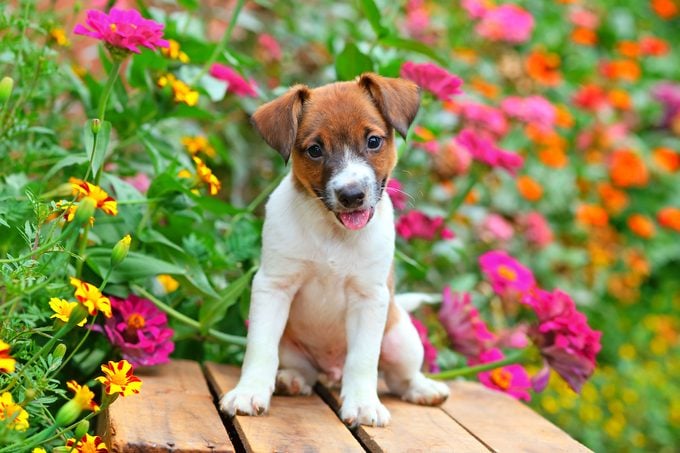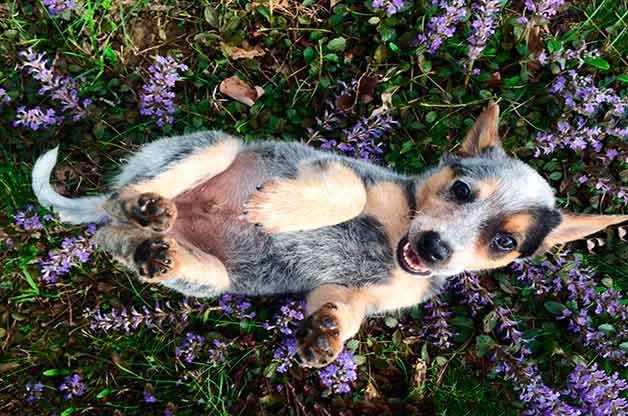The Ultimate Guide to a Dog Friendly Backyard
Updated: Jun. 12, 2023
Discover how to design a garden or landscape with dogs in mind. A dog friendly backyard keeps your furry pals safe, happy, and healthy.

Dogs are your best buds, honorary members of the family and protectors of the pack. But as they rambunctiously romp around the backyard, they may be wreaking havoc on your outdoor space. Live peacefully with your beloved doggos by following these simple tips for a delightfully
dog friendly backyard.
Check out the top 10 pet friendly indoor plants for dog and cat owners.
Avoid Using Lawn Chemicals
How do I make my backyard both dog- and bird-friendly? asks Birds & Blooms reader Susan Miller of Milwaukee, Wisconsin.
Kenn and Kimberly Kaufman say, “The good news is that making a yard safe for dogs also makes it safer for you, your family and the birds. The most important thing gardeners can do is avoid treating their lawns with chemicals. Recent studies indicate a correlation between lawn chemicals and cancer in canines. These chemicals can also harm insects and the birds that feed on them. Embrace the idea of a less treated lawn to benefit all living creatures.”
Pave a Safe Exercise Path
Dogs need a place to run and patrol, or they may get into mischief. Create a pathway—perhaps along the edge of a fence or in a side yard—with durable materials such as bricks, flagstones or mulch. When choosing mulch, beware. “Wood chips can be a problem since dogs like to chew on wood,” says Melinda Myers, Birds & Blooms garden expert. “Mulch and twigs get lodged in their mouths, and they may eat some pieces that wreak havoc on their digestive system. “Avoid cocoa bean mulch,” Melinda adds. “The chocolate-based mulch can make dogs sick or can even be deadly.”
Are lilies toxic to cats and dogs?
Create a Pup Playground

Every dog owner knows that pups love to dig and play. Designate a small, shady spot in the yard just for them. Bury their bones and toys in a dirt-filled or sandy area and give them freedom to dig. Put out toys that are just for outside, and make an outdoor tunnel or add a viewing bubble in the fence so they can patrol the area from the safety of their fenced-in yard.
Avoid these houseplants that aren’t safe for dogs.
Designate a Potty Place
Train your pup to “go” in a specific spot in the yard. Each time you take her outside, head immediately to that spot. Praise her often and she’ll catch on quickly. “Some dog owners use pea gravel or even artificial turf for potty areas,” Melinda says. “It’s indestructible and blends nicely with the rest of the landscape.” For male pups, put out a piece of tall driftwood or, for a bit of whimsy, add a replica fire hydrant.
Here’s how to keep cats from killing birds.
Choose the Right Plants
Select grasses, ground covers and shrubs for garden edges. “No plants are truly dog-proof, but many perennials and shrubs survive the abuse of rambunctious dogs,” says Melinda. “Avoid those with larger leaves, which show the damage more readily than those with smaller leaves.” Keep fleas away by planting lavender, peppermint or rosemary. But still check your dog often for fleas and ticks. Plant your flowers and veggies in raised beds or place containers throughout the garden to discourage curious canines from bounding through garden beds.
Provide Shade and Fresh Water
Offer plenty of water and shelter, especially if your dog spends time outside in hot weather. A stylish doghouse offers a shady spot to store food and water.
Put Dog Safety First
Some plants, such as boxwood, cardinal flower and elephant ear, are toxic to dogs. Check the ASPCA website for an extensive list of plants that are harmful to your furry friends. When using fertilizers, make certain they are natural, organic and pet-friendly. Your healthy pup will thank you!
Think Like a Dog
“Watch your dog’s patrol patterns and work with them instead of trying to change the habit,” says Melinda. Consider the breed, size, and temperament of your pooch when you landscape a dog friendly backyard. The better you accommodate their needs, the happier your pup and you will be to share the space!
Next, find out if poinsettias are poisonous to cats and dogs.





















